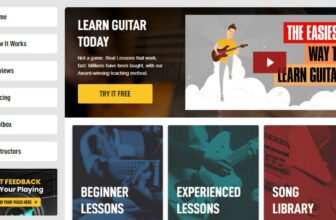Guitar Fretboard Basics – The Ultimate Guide
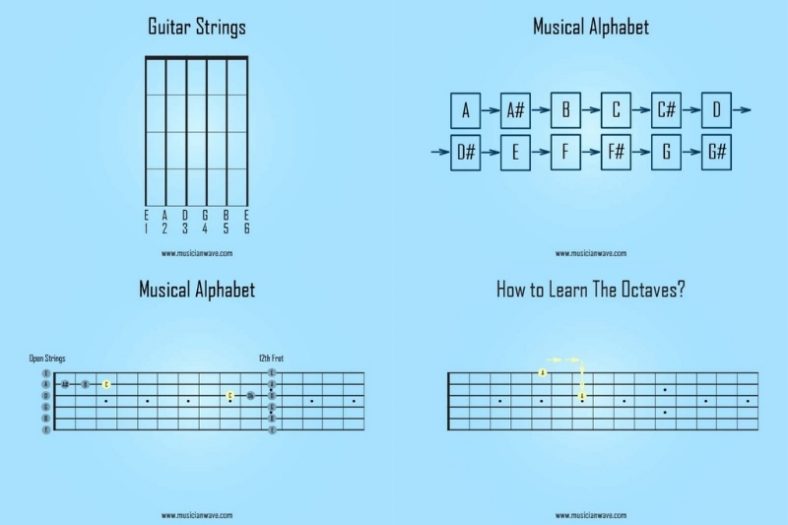
The guitar fretboard can seem quite intimidating at first, but understanding a few simple concepts can make it a lot easier to navigate!
Learning all the string names, the natural musical alphabet, octaves, and scales are the first things that you need to learn when you first start playing the guitar.
Contents
Guitar Strings
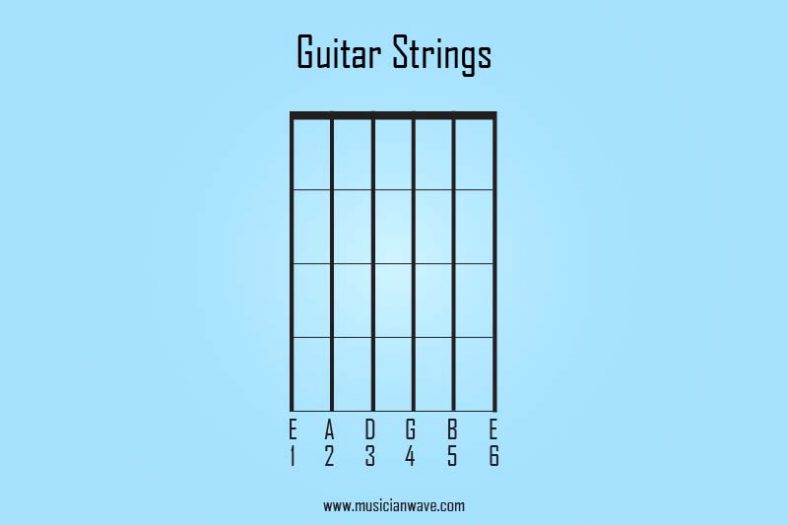
As you can see from the diagram above, the strings on the guitar go as follows: Low E, A, D, G, B, and High E. An easy ‘mnemonic’ (putting things in a sentence to help us remember things better) for remembering the names of the strings is: “Eat All Day Get Big Easy.” I know, but a mnemonic doesn’t work if it’s not something funny, or silly. Anyway, once you learn the names of all the strings you can learn other stuff much easier.
For example, those 6 notes repeat all the way to the 12th fret of the guitar, and that’s why all guitars have either double dots or some sort of a special inlay on the fretboard.
Natural Musical Alphabet
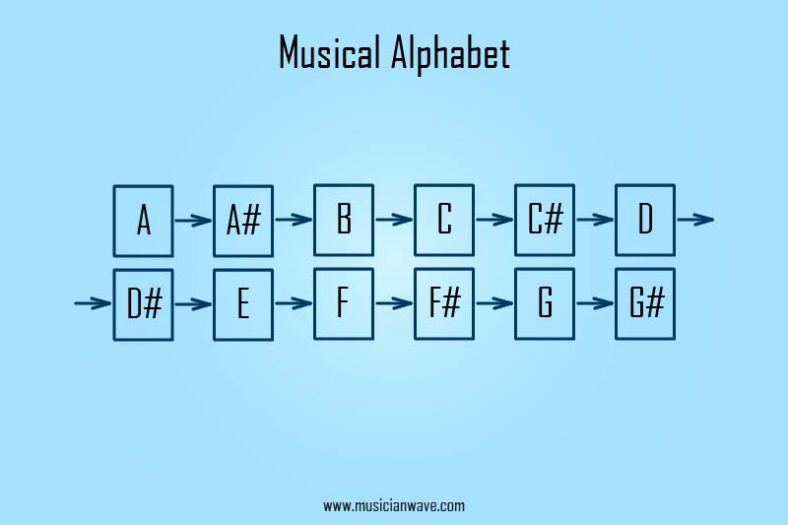
The musical alphabet consists of twelve notes, always in the same order. A, A#, B, C, C#, D, D#, E, F, F#, G, G#. After the G# you go back to A, only this time it’s an octave higher, and the alphabet just keeps looping, again and again, reaching higher octaves.
Now, the example shown above is one of two ways that you can write the musical alphabet, and the second way is to use flats, instead of sharps. A, Bb, B, C, Db, D, Eb, E, F, Gb, G, Ab.
The difference between the sharps and the flats is the pitch. A sharp note is when we ascend up in pitch, and a flat note is when we descend down in pitch. Whether you choose to call the note A# (A sharp), or Bb (B flat), it’s completely up to you, meaning you can go both ways, whichever is easier for you. You just need to know that there are two ways to go about it.
One thing to remember is that there are no sharps or flats in between B and C, and E and F, and that’s just something to remember. That’s why there are no black keys between those notes on a piano.
Applying the Musical Alphabet
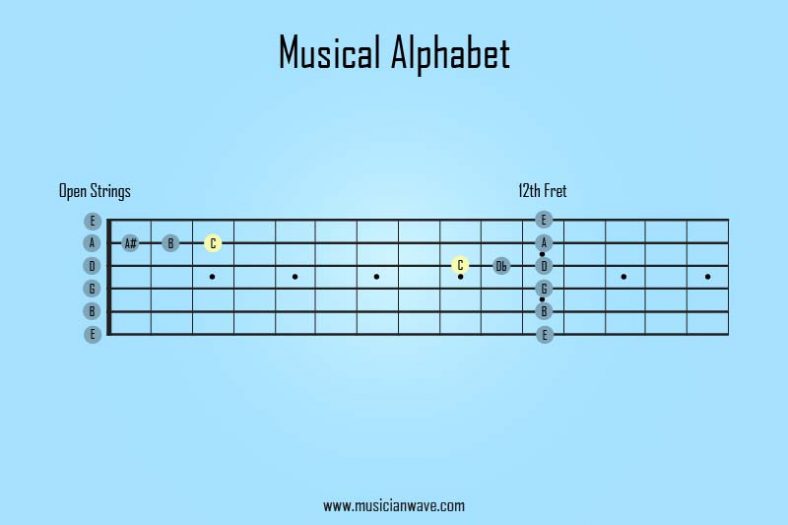
Now that we know the musical alphabet is the key to figuring out and not on the guitar fretboard, how do we find those? Well, in time this will become second nature, but for now, you need to have reference points, and you kind of already know them.
Now that we know the names of the strings, and we know that they repeat in the same order on the 12th fret, those will be our two reference points. Starting from the Low E, A, D, G, B, and High E, we can count and find any note we want.
Take note of the diagram above, where if you want to find the C note, you can do it easily on any string on the guitar. If, for example, you want to find C on the A string, you just start with an open A note and count up the musical alphabet until you get to the C. In this example it would be: A, A#, C. Pretty easy, right?
The same goes if you’re trying to find the note closer to the 12th fret. In that case, you count down, with the only difference being that you use the flats this time, instead of sharps. So in the next example, we will find the C note on the D string, and going from the D note on the D string on the 12th fret it would be: D, Db, C.
This is very important to understand early on, as it will help you learn chords and scales much, much easier. For example, many chords have the same shape, only a different root note. Once you know where that root note is, you pretty much know all the chords, with learning only one shape.
Even though there are a lot of scales, the most important thing in playing them is also the root note, so again, if you know exactly where on the fretboard is the note C and you start playing the scale from there, you’re good to go. When I first learned to apply the musical alphabet to the guitar, it was kind of revolutionary and improved my skills vastly.
How to Learn The Octaves?
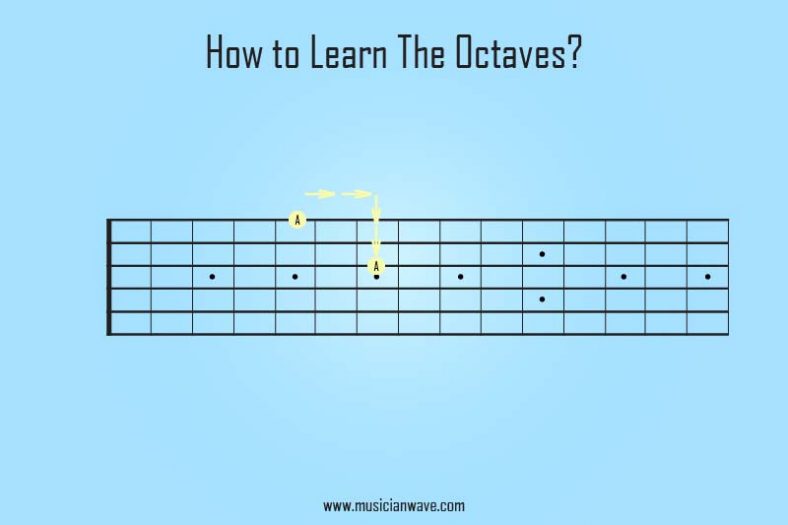
You can use some shortcuts to learn where the octaves are on the fretboard and by using those it will be much easier to find the exact notes, and even learn them by doing some exercises which we’ll talk about soon.
The first octave shape that we will learn, and the first shortcut for that matter only applies to the Low E and the A string, and it’s the one that’s shown on the diagram above. To easily find the same note on a higher octave on the 5th and 6th string is to simply just go 2 frets up, and 2 strings down, and there’s the same note only an octave higher. This goes for every note on the 5th and 6th string.
The second octave shape applies to the G and the D strings, so the 3rd and 4th strings on the guitar. In this case, we need to go 3 frets up and 2 strings down to get to the higher octave note. The only difference for the 3rd and 4th strings is that instead of 2 frets up, you go 3 frets up.
Also, another important thing to remember is that any note on the High E string is the same note as the one on the Low E string, only 2 octaves higher.
Exercises to Internalize The Fretboard
There are many ways to exercise what you’ve just learned and you can even come up with your own exercises if you want to make this a little bit more fun. It is essential that you practice all the notes on the fretboard once you’ve understood them, and that’s why there are many different ways to do this.
The first exercise is to play all the natural notes (excluding the sharps and flats) on one single string. Go up and down the fretboard on one string, and verbally say which note you are playing. Repeat this for all the strings and as many times as you need.
The second exercise is to learn one note on all the strings. In this case, you should pick a note, for example, A, and play it on every single string, starting from the Low E, all the way to the High E, and back again. You should do this using a metronome, try to set it to 30 or 40 BPM, and gradually speed it up once you’ve learned all the notes.
One great tip for practicing is to have a tuner running while you do so, and if your guitar is tuned correctly (which it should be), it will show you exactly the note you’re playing so you can easily double-check if you’re playing the correct note.
Conclusion
The guitar is an instrument with many parts that seems a lot more intimidating than it really is, and what you’ve learned in this article will help you tremendously to achieve the level of playing that you’ve always wanted. The more important thing is to have fun while doing so, and know that it doesn’t take long to learn, understand, and internalize the fretboard. Naturally, guitar music theory books are also a great source of information on this topic.

